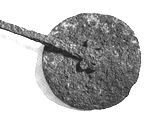At an upcoming 'hammer in' style event involving the Ontario Artist Blacksmith Association, one suggestion offered was having participating blacksmiths work with pre-cut 8 inch steel circles.
Here are some historical objects - using roughly the same starting shape:
One interesting factor related to Viking Age objects - is that 20 cm / 8 inches marks about the largest size individual measurement of any object forged out of what then was small scale bloomery / wrought iron.
There are two reasons for this :
- The scale of the working forges most commonly used provided a 'ball of heat' about the size of a grapefruit (at best). So just large enough to permit a forge weld on an axe.
- Because of the fibrous texture of the bloomery iron material, it is physically very difficult to work out a thin, large, piece of plate. Those with experience with wrought iron know that as you push it during forging, it can start to de-laminate, requiring re-welding to solidify. Often these fractures tend to diagonal lines - which as you can imagine create a special problem re-welding as the material gets thinner.
So when you examine iron artifacts from the earlier period, you see larger forms are made up of a number of smaller pieces, riveted together. Cauldrons are the perfect example of this. Even helmets are typically either a right and left half - or a top skull with additional pieces for the sides.
There are a number of samples of this flat disk cooking tool on a long handle (underneath showing pair of rivets attaching). The disk has slightly upturned edges.
A small cooking pot. A dished lower bowl surrounded by a
set of plates curved into a cylinder. The handle made of a piece of flat
bar.
As I have detailed in articles in OABA's Iron Trillium, Cast Iron is not common in Europe until more or less the end of the 1500's into the early 1600's. This matches the effective start of the Settlement Era here in North America.
Looking to objects at Jamestown (Virginia, c 1610), you see some small cast iron cauldrons, in the range of 1 - 2 gallons, but only in the hands of the wealthy. The more common people are still using pots of bronze / brass - or importantly, forged wrought iron plate.
As I have detailed in articles in OABA's Iron Trillium, Cast Iron is not common in Europe until more or less the end of the 1500's into the early 1600's. This matches the effective start of the Settlement Era here in North America.
Looking to objects at Jamestown (Virginia, c 1610), you see some small cast iron cauldrons, in the range of 1 - 2 gallons, but only in the hands of the wealthy. The more common people are still using pots of bronze / brass - or importantly, forged wrought iron plate.
Replica at Jamestown Settlement - Taken from the underneath side, you can see how pieces of flat bar have been riveted to the deeply dished bowl. Again, this cooking pot is about 8 inches in diameter.
As you look into what most of us would consider the Canadian Settlement Period (1750 - 1850) you will see increasing use of cast iron, specifically as much larger cauldrons. There are still many cooking pots and flat pans made of forged plate. Most first cabins had open fire places, and a common design was a deep fry pan with and extremely long handle. The bowls are typically now a flat bottom with slanted sides. Most of these are considerably larger, but again working with the 8 inch size would create a distinctive object
Replicas at Fortress Lewisburg (c 1745) - A collection of long handled fry pans. (again replicas)
As a commercial note :
I have made a great number of replicas of cooking tools from all these time periods - and these objects specifically.

























No comments:
Post a Comment